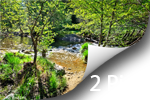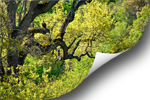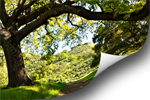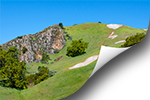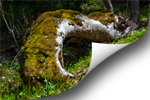
5 Walk on the Wild Side
This is not about what you may think; this is about some serious hiking! After my initial visits to UCB Campus, I felt the urge to experience some wide-open ranges again. So I decided to benefit from the generous sunshine that had reappeared by visiting the Bay Area's largest wilderness area, the Sunol-Ohlone Regional Wilderness. The name deserves to be written in italic since the area is huge, maybe ten times as large as the Nacka Reservation, for you Stockholmers.
This contiguous wilderness is not a wilderness in the European sense of the word. Cattle graze on the upper meadows, albeit in limited numbers, mostly to keep the ranges open, I believe. Still, its hilly and roomy nature invites wild animals of all kind to take up residence, and the hiker may occasionally witness these marvels of nature. Lucky are those that have seen the "big three" in one day (including the night): the eagle, the falcon and the mountain lion. This was not to be for me, but I still saw best "seconds", which it will be my pleasure to present to you.
After half an hour's drive across the Berkeley Hills and alongside our new acquaintance, Mount Diablo (Chapter 3, Good Old Nimitz), a very pleasant country road brought me to the entrance of the park. Here came the first surprise: 35 years ago this was a real wilderness with just a few benches for barbecuing and no other service for visitors. Nowadays, there is a visitor centre, a kilometre long complex of picnic sites and so forth. More worryingly, you are no longer allowed to park where my old trail started, so the hike I had intended was prolonged by close to an hour's access detour.
But it was worth it! The hike initially went along the renowned Alameda Creek, almost a river now after the intensive spring rain, but hardly a brook 35 years ago when it had not rained for a full year. To my left, the hills started to rise slowly, with hardy Californian oak crowning their crests. To my right, the creek gurgled along, sheltered by groves of silvery sycamores, willows and, increasingly, bay trees, with the odd huge oak tree taking its rightful place among its more modest siblings. There is a saying that the creek was even more majestic in pre-Columbian times. The Spaniards, when first venturing upon it did not call it Alameda (the "Arcade") for nothing.
I decided to follow their example and pay the rushing stream a closer visit. Deviating from the broader road, off I went into the wild river glades to admire the white gush of the waters and the cool shade of the "Arcade". Unfortunately, the cool path proved to be a cul-de-sac, forcing me to fight my way back to the road through intense underbrush and a high cliff. But I was awarded for my troubles. When turning around after the arduous ascent I heard a whooshing sound and had the good luck of observing a huge bird descending on a giant oak tree along the river. When looking closer I glimpsed two of its siblings already roosting on the same branch. Out went my camera and, fortunately, I was able to catch the birds before all of them alighted, awakened by the sharp shutter "clapunck" of my digital Nikon.
I first thought that these were eagles resting majestically in the oak tree. But a knowledgeable fellow hiker advised me that I was observing Turkey Vultures, among the greatest birds found in the US. Only the Bald Eagle surpasses them in size. Both species have a wingspan of about two meters, the eagle a bit more. We are lucky that "Their Feathered Hugenesses" prefer carrion to fresh meat, else you may feel uncomfortable having them around, expecting them any minute to whoosh down on you with their enormous wings and pick at your eyes!
Heartened by this scene, I continued following the creek's gurgling, which gradually became more intense. Eventually I arrived at a small glade with a bench, which in the States always indicates "A Sight to Behold". And I was not misled. The road had risen above the creek for some time now, so I was looking about 50 meters down into a gorge where the water glittered with gushing speed, preceded by a small waterfall further up the track. It seemed that I had arrived at "Little Yosemite", one of the landmarks of Sunol. Well, there must be very few, if any other waterfalls in the Bay area for this little gurgler to be named "Yosemite". You hardly notice it unless looking hard for it. But small is beautiful and the scenery would have been worthy of admiration even without its misdirected denotation.
Just around the corner a trail took off to the left, which I gladly followed, eager to gain the high meadows. As I climbed upwards the scenery changed, with oaks becoming prevalent, if ever more sparse, and green ranges starting to open up. As I laboured along the path, I was suddenly met by whiffing dogs, which were as glad as myself to get company on this lonely trail. Two youngsters came strutting after in order to catch up with and leash the dogs in my presence; not to protect me of course, rather to avoid being caught with a park offence. Still, we managed an amiable discourse, almost a banter, as is common with youngsters. They warned me about "wild bulls" further up on the ranges and advised me to take off my shirt in the heat. In turn I admonished them to have the dogs well leashed in view of roving turkey vultures and suggested they consult their doctors immediately, for skin cancer treatment. Thus enlightened, we each continued along our respective solitary paths.
On and on I climbed, ever upwards, until very few oaks were left to provide me with shelter. Eventually, I happened on a group of fellow wanderers, with one of them lingering behind his more rash companions. I soon caught up with the lonely gentleman, of mature age, who proved to be an entertaining companion for the continued steady ascent. His first name was Harry. His family name, Pottol, I first misheard it as the one of "You Know Who" (or, rather, the one who got to grips with "You Know Who"). He explained to me that his was a hike organised every Thursday, by a fellowship of wanderers from Cupertino. These hikes had originally been carried out by his Alma Mater and accompanied by a guide. The group was still continuing despite the College having dissolved the original arrangement a long time ago. This in turn inspired me to tell him my often told story about the "Medium Term Planning Conference for Europe", which had started out as an official OECD Committee, but simply continued on for decades even after the OECD had abolished it.
Not to be bested, Harry decided to share his hard-gained experience and wisdom concerning the origins of the recent financial crisis. In his view, the ultimate roots of that disaster were to be found in the period immediately following WWII. As his tale gradually advanced in time and we continued climbing the slopes, we soon arrived at a crossing of paths, were he was supposed to walk downwards to the right and I was to continue upwards to the left. His companions, barely glimpsed from afar, were eagerly awaiting his catching up, so to my dismay he never arrived at the events more directly occasioning the recent crisis. His intimate knowledge will never be fully revealed to me, to my regret. Instead he spurted after his friends and soon disappeared in the midday haze.
Alone again, I continued the ascent to the eagerly awaited Cerro Este summit, the median target of my roundtrip. The hardy labour was oftentimes interrupted by interesting scenery. Once, when directing the camera towards a beautiful solitary oak far below my path, I suddenly saw that I was not the only one admiring the surroundings. A lonely Coyote looked as longingly towards the far off hills as I did towards him. A peaceful meeting of the minds indeed!
But this was not all; a short distance further up the slope, two hardy hikers had their binoculars up, gazing intensively in the opposite direction. I tried to draw their attention to the solitary predator, but they cordially declined my offer to gaze in that direction, preferring to observe a diminutive bird they assured me was extremely rare, but that I did not find that exhilarating.
So on I went with my exercise for another half hour's steady climbing (you may have noticed that the half hours accumulate; they may soon become a figure of speech!). Suddenly I encountered a big circle of an earth mound, with a small pond in the middle, not unlike the remains from Iron Age fortifications, like we sometimes find in Europe. Curious as I am, I went off the trodden path to investigate. Suddenly, I saw a movement in the grass, out went my camera and "clapunck!" it sounded, before I even glimpsed the prey. I never actually saw it clearly, since the camera's shutter noise had already scared it off. However, on the camera's back screen I could gather that I had fired at a Ground Squirrel, pointing its nose at the intruder. Thus, the "Iron Age fort" turned out to be a colony of these simultaneously curious and evasive creatures!
By then, the summit beckoned, barely half an hour's walk ahead. I hastened on, since it was already way past noon, and my stomach started to grumble. Soon I was standing on the top of a ridge that extended far from South to North and granted me a comprehensive vista of the Wilderness. California is known for its "Golden Hills", but after the heavy rains earlier in spring, the hills looked much more like alpine meadows, even if the odd oak belied that analogy. I sat down on a conveniently placed bench and said to myself that I could easily envisage the meadows full of grazing cattle, as is common in the heights back home in Austria.
Hardly had I finished the thought than what looked like a raging bull came charging full speed towards me. Only about ten meters before contact the animal slowed down and I discovered that it was a calf after all and only curious about my presence. Soon he was joined by a heard of youngsters anxiously ogling me as if I intruded on their home turf. Undisturbed, I reached into my rucksack only to discover that I had forgotten my sandwiches back home! This was no laughing matter! After ingesting two apples and all the water I was glad to have packed in the morning, I had no other choice but to shorten the trip from the foreseen seven hours down to five and take the shortest route back down to the car.
Soon I was back in the oaken ranges, taking pictures on the run, and arrived towards the end of the trip at a lovely little brook by the name of Indian Joe Creek. From then on, the descent went in lovely shadow, crisscrossing the creek over and over again. Along the way, I could admire a beautiful rock formation and cave, eagerly attended upon by happy youngsters. Eventually, the crook merged with the Alameda and I was back at the car.
I hope I haven't tired you unduly with this lengthy account; I could not bring myself to make it shorter, excited as I was by that eventful walk in nature, totally immersed in lovely green, a colour hitherto unseen in the Bay Area regional parks during my earlier visits some 35 years ago.

